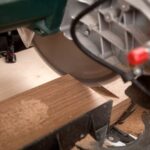Introduction
Making your own woodworking bench has many benefits. Not only is it less expensive than buying one, but you can customize it to fit your space and needs. You don’t have to worry about spending time searching for the perfect one ” you can make an exact replica of a beloved classic or design something that is unique to your specific workspace. Moreover, having the satisfaction of creating something with your hands will add even more enjoyment when using it. Furthermore, making your own bench helps build essential skills such as carpentry, joinery, and mechanical arts that can come in handy when completing other woodworking projects. Finally, constructing a well-crafted workbench provides practice in precision and accuracy since measurements need to be taken properly for the pieces to fit together properly; this practice builds confidence when attempting more difficult tasks.
Important Considerations When Building Your Own Woodworking Bench
When making your own woodworking bench, it is essential to pay special attention to the materials you use. Choose robust hardwood and high-quality, durable tools to ensure the construction of your bench is high-quality. You may also want to consider any other features you will need for your projects ” for instance, you may wish for vices or a grooved platform, which could require thicker pieces of lumber. In regards to safety, take into account any difficult or dangerous parts of the construction process that you should be aware of beforehand. It might be helpful to consult experienced woodworkers for guidance before starting. Additionally, make sure there is plenty of space for machinery and needed items such as saws and chisels when planning the construction of your bench. Finally, take into account budget restrictions when building your own woodworking bench; calculate how much money you can afford to spend before shopping around for materials and tools.
Essential Tools and Materials for Constructing a Woodworking Bench
For those looking to create their own woodworking bench, it is important to have the right tools and materials. The essential tools needed are saws such as a jigsaw or miter saw, a drill, clamps, measuring tape, a square, sandpaper, and screws. Other tools for building benches may include dowels or pocket hole jigs. Additionally, materials such as 2x4s and 4x4s for framing, plywood for table tops and shelves, lumber for posts and supports that hold up benches or give them form or shape, hinges and locks to assemble doors on cabinets underneath the workbench, finish nails for installing trim pieces like crown molding or shoe molding around cabinet boxes and drawers. Furthermore¸ various decorative hardware such as knobs can be used to accessorize cabinets to add ornamental appeal. Lastly, it is important to keep in mind that any techniques used should adhere to proper safety procedures when utilizing power tools. Now with the right tools and materials at hand constructing your own woodworking bench won’t take long at all!
Detailed Step-by-Step Guide to Assembling the Woodworking Bench
Step 1: Gather the Supplies
First, you will need to gather all of the supplies necessary to build your woodworking bench. You’ll need 4 wooden planks that are 2” x 12” in length, 8 flat corner braces, 4 countersinking screws, 16 small nails or screws appropriate for the type of wood you are using, carpenter’s glue, a drill with a small boring bit and an electric saw.
Step 2: Prepare the Wood
Once all of the supplies have been acquired, the wood must be prepared. Using a damp cloth, clean off any dust or debris on each plank before beginning. Then perform any necessary measurements; mark each plank in order to ensure accuracy while sawing. Use the electric saw to cut each piece down to size according to measurement markings previously made.
Step 3: Assemble The Pieces
Once all wood pieces have been appropriately prepared and cut down to size it is time to assemble them together. Apply carpenter’s glue onto each edge that will meet when connecting two boards together as this will increase stability once complete. Place two planks parallel with one another and then align and clamp flat corner braces at their intersection where they meet in order to keep them stable while connecting with nails or screws tightly until the boards are securely connected together. Repeat for remaining two planks until complete frame is assembled.
Step 4: Attach Legs
After assembling the main frame of your bench it will now be necessary to attach legs so that it can stand upright safely on its own four feet. Measure out even amounts from each board end as not to create an unleveled discrepancy within its base structure then use drill and boring bit to leverage rable countersinking holes into holes each leg piece inboard should fit perfectly over those measurements after preparing these four space accordingly use nail or screw tip either leave enough material left over so they recede into surface without protruding outward Finally set place legs inside proper place attaching each side securely so that woodworking bench stands up without wobbling unstablely
Step 5: Sanding and Final Touches
Now that everything has been successfully assemble use sandpaper grit between 100-120 depending hardwood used sand all edges smooth fineness and adhere closely specifications also performs any final touches finish painting staining veneers as furniture personal preference needs last step would admiringly gaze upon creation own making either placed inside home workshop garage or study room enjoy fine craftsmanship handiwork
Expert Tips for Making the Most of Your Woodworking Bench
1. Choose a sturdy material ” when choosing a material to make your woodworking bench out of, look for something that is strong and durable, such as oak or maple. Avoid softer materials like pine which won’t hold up against frequent use.
2. Draw a plan before you begin ” creating a detailed plan will help ensure that your woodworking bench comes out exactly as you envision it. Decide in advance how tall the bench should be and what shapes of wood to use before starting the project.
3. Use appropriate tools ” invest in the right tools for the job including an air powered pneumatic tool set, sanders, saws, routers, domestic buffers, square-headed bolt cutters, drill press with adjustable speed settings for slow and precise drilling operations, router jigs and doweling tools.
4. Have precise measurements ” all joints must have accurate measurements or else the entire woodworking bench may be compromised structurally once put together. To get precise measurements take advantage of digital measuring tapes which automatically record dimensions with less room for user error.
5. Build each end first ” After measuring all pieces of lumber intended to build your workbench start by constructing each end first then slowly adding second floor boards across the top finishing with top shelf construction and lengths chosen previously. This will make assembling easier because each post only needs attaching at one corner instead of both ends on the long benches making assembly much faster and easier than hardware stores kits supplied flat packs designs.
6. Install secure pegboard walls – Finalize the structure by setting up pegboard walls on either side so screws, nails, hammers and other supplies can be hung within close reach while working on projects without taking up any floor space on the finished product itself offering neat organized area when completed; also ideal for hanging planks off during plane work due to ease of install/removal effecting optimal material support using fewer clamps.
Creative Finishing Touches for Your Woodworking Bench
One way to make your woodworking bench stand out even more is to add a few creative finishing touches. Here are some ideas to consider:
1. Paint it: Use a bright color or pattern to show off the beauty of your woodworking bench. A white, black, grey or navy blue color will give it a modern look, while red or green may be more traditional in hue. With a little creativity and fun stencils, you could also create a unique design on the surface of the bench that speaks to your particular style.
2. Add Accessories: You can also customize your bench further by adding accessories like carved moldings and decorative brackets. Other knick-knacks like ornaments, vases, lamps and frames can be used as accents too! Try combining these elements to create a piece that’s truly one of a kind.
3. Stain It: Staining is an easy way to enrich the appearance of your woodworking bench and give it an aged look. You can choose from an array of colors such as maple, oak or walnut to match your existing furniture pieces in the space. Some special stains can also enhance and protect against wear-and-tear so you get longer enjoyment out of the woodworking piece.
4. Change Knobs & Handles: If you want something a bit more unique than screws holding together your woodworking project, you can use door knobs, cabinet handles and even drawer pulls instead! Opt for metal pieces with intricate details or wooden knobs with interesting shapes if you want character added into the mix (plus they make it easier for opening drawers and cabinets).
Easy Maintenance Tips for a Long-Lasting Woodworking Bench
Having your own woodworking bench that you have built yourself is a great way to bring a unique charm and style to any area. You can customize its design to perfectly fit your space, making it both practical and aesthetically pleasing for working on hobby or small construction projects. However, having an effective workbench isn’t quite complete without proper maintenance. Here are some easy tips to keep your bench in long-lasting condition:
1. Keep It Waxed: Regularly waxing the surface of your woodworking bench will help it stay protected against various kinds of spills, marks and dust. The thin layer of wax will also create a barrier between the surface of the bench and the material you’re working with, allowing the latter to slide more easily over the top.
2. Clean Up After Project: Make sure after every project you clean off all sawdust, residue, and debris that may have been accumulated during construction or sanding processes. Leaving behind these particles can cause future problems; including staining as well as damage to other tools stored besidethe workbench due to getting caught in any exposed nails or screws.
3. Check Condition Regularly: Update hardware whenever necessary by checking them regularly for tightness by using a screwdriver if needed just tighten them up a bit. Also look for any large splinters or gouges which might be developing out on the edges where tools usually rest on top of the woodworking bench; they could become sharp enough to cause injury when left unchecked over time. This goes hand-in-hand with noticing any weak points in parts of the workshops base; so make sure these areas are constantly inspected and at least maintained if not fixed along with updating any damaged hardware accordingly!
Summary
Making your own woodworking bench offers significant advantages over purchasing a manufactured one. For starters, the cost of buying and shipping a manufactured workbench can be enormous in comparison with making one yourself. Additionally, when you make your own, you dramatically reduce the risk of having something arrive damaged or incomplete due to an oversight in transit. Furthermore, making your own means that you can customize it specifically for your needs and preferred working style. With exact measurements taken from the space you wish to place it in, you’ll ensure maximum utilization of your space and precise placement within tight tolerances. Doing this also gives you greater control over the type and caliber of materials used in the bench, enabling thicker surfaces or custom supports and hold-downs specific to a task. Finally, there is great satisfaction derived from taking the time to do it right; put simply, handmade items tend to last longer by being built stronger than their showroom counterparts.

Hi everyone! I’m a woodworker and blogger, and this is my woodworking blog. In my blog, I share tips and tricks for woodworkers of all skill levels, as well as project ideas that you can try yourself.





